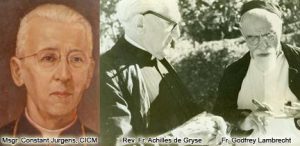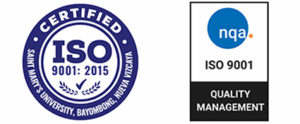History
A BRIEF HISTORY
 Saint Mary’s University traces its roots back to the dream and initiative of Msgr. Constant Jurgens, CICM, one of the earliest CICM missionaries to arrive in the Philippines. In pursuit of his dream to establish a school for the Christian education of the parishioners’ children, he purchased a lot and some materials. Upon his recall to Europe, his successor, Rev. Fr. Achilles de Gryse, CICM, saw his dream come true.
Saint Mary’s University traces its roots back to the dream and initiative of Msgr. Constant Jurgens, CICM, one of the earliest CICM missionaries to arrive in the Philippines. In pursuit of his dream to establish a school for the Christian education of the parishioners’ children, he purchased a lot and some materials. Upon his recall to Europe, his successor, Rev. Fr. Achilles de Gryse, CICM, saw his dream come true.
Their efforts resulted in the inauguration of the Saint Mary’s Elementary School in June 1928. The High School Department was opened in 1934 under Rev. Fr. Godfrey Lambrecht, CICM.
In 1947, the College Department started with the offering of Associate in Arts, Bachelor of Science in Education, Bachelor of Arts and Junior Normal course (Elementary Teacher’s Certificate). Gradually, the course offerings expanded with Bachelor of Science in Commerce including major in Accounting in 1951, Bachelor of Science in Civil Engineering in 1955 and the Graduate courses in 1962. Through the years, Institutes, Colleges/Schools were established with more program offerings. Many more academic units opened including the Schools of Accountancy, Business, Computing Sciences and Information Technology, Engineering and Architecture, Health Sciences, Public Administration and Governance, Graduate School, and the College of Law. In 2016, a re-structuring was done which resulted to the merging of selected schools. Currently, the tertiary level is composed of five schools and a college: School of Accountancy and Business; School of Engineering, Architecture, and Information Technology; School of Health and Natural Sciences; School of Teacher Education and Humanities; School of Graduate Studies; and College of Law. Rapid campus expansion started in 1968 with the purchase of the 6.5 hectare campus along the Magat River, and the construction of the academic building named in honor of Rev. Godfrey Lambrecht, CICM. The college department moved from the old campus to its present site in 1969, two years after the ownership and management was turned over to the CICM. Construction of other buildings continued over the years, thus providing more learning space for the students. In 1994, the University Building, now Constant Jurgens building, was constructed to commemorate the elevation of Saint Mary’s College to university status, with Rev. Fr. John Van Bauwel, CICM as the first University President. With the installation of Rev. Fr. Jesse M. Hechanova, CICM as the second University President in 1998, more edifices for different purposes like the Institute of Science and Mathematics Building, St. Joseph’s Inn, Sacred Heart Center, High School Building (Phase I), Balai na Alumni, Jubilee Library Building, and SMU FEA Multi-Purpose Cooperative Building were put up. The year 2005 saw the installation of Rev. Fr. Manuel D. Valencia, CICM as the third University President and with him at the helm, two four-storey buildings were constructed, one in commemoration of the CICM centenary in the Philippines (Florentina) and the other named after the CICM founder Rev. Fr. Theophile Verbist.
As the University’s course offerings increased and its population expanded, new buildings were constructed to cater to the needs of the students and the ever changing thrusts of education and technology. The construction of the Engineering Laboratory Building, now Renato Seargent Building, in August 2011 not only is a testament to the commitment to the CICM educational apostolate of Rev. Fr. Renillo H. Sta. Ana, CICM, as the fourth University President (installed in 2010), but also as a grateful testament to the dedication of Rev. Fr. Renato Sergeant, CICM, who generously served the SMU community for 24 years. In mid-2014, the Joseph Van den Daelen Building was inaugurated to house the Senior High School. The following year, the Maurits Vanoverberg Building was rebuilt and the St. Aloysius Gonzaga Building was put up at the Grade School Campus. Construction of more edifices continued in 2016 like the Clement Daelman Multi-purpose Building at the Junior High School Campus, the Georges Debusschere Building, and renovation of the Gerard Decaestecker Building both in the College Campus. In 2017, the inauguration of the Antonio Tanchoco and the New Engineering Buildings took place.
In its quest for academic excellence, the University has achieved various levels of accreditation for its programs through the Philippine Accrediting Association of Schools, Colleges and Universities (PAASCU). It has gained reputation as one of the best training institutions for future teachers, having been named as one of the five most outstanding Teacher Education Institutions in the Philippines in academic year 1983-1984 and designated as a Center of Excellence for Teacher Education by the Commission on Higher Education in 1996, 2008, and 2016. It was designated as Center of Development in Civil Engineering in 1999, 2010, and 2016 and Center of Development in Information Technology Education in 2007 and 2016. SMU was also one of the institutions nationwide granted Full Autonomy by CHED in 2001 and 2016. It was recognized as International Quality Summit (IQS) Awardee-Gold Category by the Business Initiatives Directions based in Madrid in 2013. Graduates of SMU has excelled in licensure examinations, consistently producing a high percentage of board passers in most of its board courses.
True to the challenge of maintaining quality education, the Institution has submitted itself for accreditation of its programs by the Philippine Accrediting Association of Schools, Colleges and Universities (PAASCU). Level I accreditation was granted to the Liberal Arts, Commerce and Education Programs in 1983, Level II in 1985, Level III in 1988 with Level III re-accreditation for the Liberal Arts, Education, Commerce and Accountancy Programs in 1999 and Level II in 2004 (except Accountancy), and Level III re-accredited status in 2012 and 2015. For the Civil Engineering Program, Level I was granted in 1995 and Level II in 2001, re-accreditation for 5 years in 2006 and Level III re-accreditation in 2012, and re-accreditation for another 5 years in 2018. The High School Program was granted Level I accreditation in 1988, Level II in 1996 with Level II re-accreditation in 1999, Level II re-accreditation for 5 years in 2016. The Grade School Program was granted Level I accreditation in 1985, Level II in 1989 with Level II re-accreditation in 1999, Level II re-accreditation for 5 years in 2005 and Level III re-accreditation for 5 years in 2016. For the Accountancy/Management Accounting Program Information Technology Program, and Nursing Program, Level I accreditation was granted in 2015 and another 5 year re-accreditation in 2018. And in 2019, the Architecture Program was granted a Candidate Status.
For the graduate programs in Arts and Sciences, Education and Business, Level I accreditation was granted in 2000 and Level II in 2003, Level II re-accredited status in 2012 and Level III accredited and 5 year re-accredited status for the following programs granted in 2014 and 2018, respectively: Educational management (PhD EDM/EdD) Program, Master of Arts in Teaching (MAT/MST) Program.
On August 2018, Fr. Fernold G. Denna, CICM formally sat as the Officer-in-Charge of the Office of the University President and also Vice President for Mission and Identity.
Recently, Dr. John Octavious S. Palina was officially installed as fifth university president of SMU.
The University remains steadfast in its vision of being a premier CICM Catholic educational institution drawn into communion by the Wisdom of God, dedicated to forming persons exemplifying excellence, innovation, and passion for Christ’s mission. Now on its 90th year, Saint Mary’s University has steadily grown and has metamorphosed into one of the most important academic institutions in the Philippines, particularly in the Cagayan Valley region.

